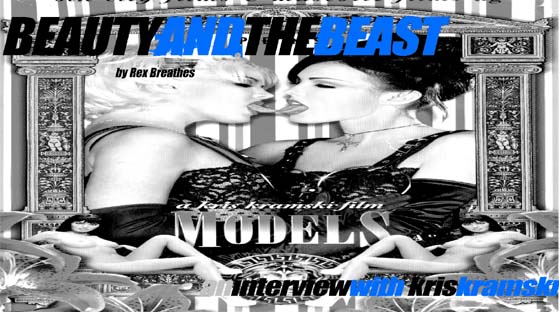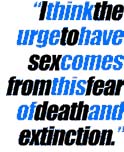
"I think that sex and death are two very close things," Kramski said. "I think the urge to have sex comes from this fear of death and extinction--that we must leave something here to carry on after we are gone. I think that if we were immortal, we would have very little concern with sex."
That led to our shared understanding that sex and death, or the creative and destructive force/urge, are like two sides of the same coin. And that idea is best represented by the ancient Hindu Goddess Kali--the giver and taker of life. Kramski wants to bring his audience to the edge of understanding this relationship between sex and death. But ultimately, Kramski says, "My higher aspiration is just to entertain people. The least any form of art can do is actually entertain. People have to work a lot and they get pushed around a lot and if I can just do something to entertain them, to make their lives easier, then I am happy."
Kramski's love of shooting on film is just as much philosophy as it is a superior look. "There's something more noble about shooting on film," Kramski said. "You respect more what you are putting on the screen because it costs money. When you're shooting on video, you don't care if it turns out like crap because it doesn't cost anything. So the whole attitude and approach (of film) is different because of the cost. The whole I-don't-give-a-shit attitude in porno comes from the fact it's shot on video." Kramski went on to tally the average cost of shooting 16mm at $20 per minute and $60 per minute for 35mm. That's just for the raw footage and developing.
Currently, Kramski has five horses waiting to burst out of the gate. He has a mind-blowing, straight documentary of his industry called Porno; Sin City is still trying to figure out what to do with that one (they may sell a soft version to HBO's Real Sex). He just finished shooting a scripted, hardcore remake of the Catherine Deneuve classic, Belle Du Jour, that probably won't be released till next year. Then there's Pornovision, a very stylized, shot-on-35mm film that he made through his own production company. Furthermore, he has a modern day Frankenstein horror/hardcore film called Gate Crashing Heaven, budgeted at 1.5 million, on hold till he can drum up financial backing. The price tag is too high for adult films or for conventional films to take a chance on him as an unknown.
Last but not least, Chloe A day At The Beach is set for release next month. Chloe is sure to raise a ruckus as it tells the tale of an innocent, abused woman who jumps from a bad relationship to a worse one when she's rescued by a doctor after her suicide attempt. The doctor manipulates the vulnerable Chloe into ever deeper depravity for his own twisted needs.
In Chloe, Kramski's actors have to stay in character, even during their sex scenes. An interesting anecdote is that Chloe, the actress, had to fake pain and discomfort during an anal scene towards the end of the film, when in reality, she was coming. (That's from the actress's mouth.)
Kramski may be the only porn director who is determining everything that happens for the camera in sex scenes. "Most directors just bring the actors
 together,
then hope something magical will happen between them. I believe the more
fake the better," Kramski explained.
together,
then hope something magical will happen between them. I believe the more
fake the better," Kramski explained.
To show Chloe coming in that scene would have
meant losing her character and the storyline of a victimized, traumatized,
drugged-out woman being manipulated for sex. Besides, Kramski pointed
out, even if you show her coming, the audience may still not pick up on
that fact. So Kramski sticks to photographer Helmut Newton's philosophy:
"The more fakeness the better."
Kramski believes a good director doesn't take a chance on whether the
audience will get what he's seeing; instead he forces the audience to
see things his way. So, faked pain and displeasure is better than a real
orgasm the audience might miss entirely, or notice, then wonder: 'how
can this character be enjoying the sex that much?' And that would destroy
the suspension of disbelief.
Kramski doesn't hide behind the attitude that he's only making porno for a living and he really wants to shoot documentaries for PBS in Africa. "If there was more money in porno, I would be very happy to be doing it for the rest of my life. But I struggle too much to make these films on a shoestring. Porno is a small business. All the hype and bullshit that there's all this money in porno, well, compared to music or TV or films, it's nothing; I work for peanuts."
I can relate. Kramski doesn't envision porno moving onto a better place, either. "I think the future of pornography is that it will become internet based . . . as TV and the internet merge together. I don't think it will be artistic; it will be practical." Kramski goes on to lament the fact that there is a lot of censorship in porno filmmaking. As an artist, it's not the free, wide-open medium that an outsider might expect.
"Pornography is very censored: you can't shoot if they look underage; if they pretend to be underage; if somebody else pretends they are underage; you can't mix sex and violence; you can't shoot interracial if you want to sell to cable; you can't mix homosexual with heterosexual because that won't sell..." In other words, we can all look forward to a lot more mediocrity moving from video stores to the internet.
Kramski doesn't like to stop working long enough to think about these things because it's depressing. He has no control over what everyone else is doing. The only thing he has command of is his films, which he works on tirelessly: spending one to two months in editing and post-production after he shoots; writing and rewriting scripts; rehearsing scenes; shooting only on film. Kramski stands virtually alone, in the company of his friend, Andrew Blake, and a handful of other directors, in offering the opposite end of the spectrum to all the I-don't-give-a-shit porno pumped out everyday.
It's a long way from the has-to-be-flawless world shooting high fashion modeling. And yet, it's the same eye Kramski brings to pornography, filming the storied marriage between sex and death in the city of Lost Angels.